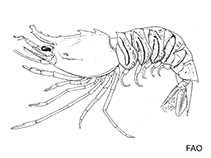Sicyonia dorsalis Kingsley, 1878
Lesser rock shrimp| Native range | All suitable habitat | Point map | Year 2050 |

|
| This map was computer-generated and has not yet been reviewed. |
| Sicyonia dorsalis AquaMaps Data sources: GBIF OBIS |
Upload your photos
Google image | No image available for this species;
drawing shows typical species in Sicyoniidae.
Google image | No image available for this species;
drawing shows typical species in Sicyoniidae.
Classification / Names Common names | Synonyms | CoL | ITIS | WoRMS
Malacostraca | Decapoda | Sicyoniidae
Environment: milieu / climate zone / depth range / distribution range Ecology
Benthic; depth range 2 - 420 m (Ref. 101592), usually ? - 80 m (Ref. 106549). Subtropical; 36°N - 29°S, 98°W - 34°W
Distribution Countries | FAO areas | Ecosystems | Occurrences | Introductions
Western Atlantic: from USA (North Carolina to Texas) to Mexico, Bermuda, Antilles (Cuba and Puerto Rico), Colombia, Venezuela, Suriname, French Guiana, and Brazil (Amapa to Santa Catarina).
Length at first maturity / Size / Weight / Age
Maturity: Lm ? range ? - ? cm Max length : 7.1 cm TL male/unsexed; (Ref. 101681)
Maximum length based from data in Tortugas, Florida, USA (Ref. 101681). Maximum depth from Ref. 79713.
Life cycle and mating behavior Maturity | Reproduction | Spawning | Eggs | Fecundity | Larvae
Spawns during spring and summer; continuous reproduction at lower latitudes, with increased seasonality of the breeding period at higher latitudes (Ref. 101677). Mating behavior: First contact, if the male was behind the female it immediately began to push under the female with its cephalothorax, but if from any other position, the male moved behind the female before pushing below it. The male then followed behind the female, it grasped or contacted the female's abdomen with its long antennal flagella, which quivered or vibrated during this "following" behavior. The dorsal cephalic region of the male, with the rostrum, eyes, and antennules, touched and prodded the female's genital area or thelycum, where the apertures to the female's seminal receptacles
are located. The male pushed upwards, tilting the female's body forward so that the genital region on the posteroventral cephalothorax was lifted well off the substratum. The male assumed the copulatory position by rolling upside down below the female, with the male's body perpendicular or slightly oblique to that of the female. In the copulatory position, the genital regions of the male and female were opposed. Copulation usually terminated when the male rolled back to an upright position and backed away slightly from the female, although the female sometimes broke off the copulation with sudden retrograde swimming by rapid abdominal flexion. After a copulation, the male frequently initiated following behavior again (Ref. 101680).
Main reference
References | Coordinator | Collaborators
Pérez Farfante, I. and B. Kensley. 1997. (Ref. 75620)
IUCN Red List Status (Ref. 130435: Version 2024-1)
CITES status (Ref. 108899)
Not Evaluated
CMS (Ref. 116361)
Not Evaluated
Threat to humans
Human uses
Fisheries: commercial
| FishSource |
Tools
More information
Trophic Ecology
Food items
Diet
Food consumption
Ration
Predators
Diet
Food consumption
Ration
Predators
Ecology
Population dynamics
Life cycle
Distribution
Human Related
Aquaculture profile
Stamps, Coins Misc.
Stamps, Coins Misc.
Outreach
Taxonomy
References
Internet sources
BHL | BOLD Systems | CISTI | DiscoverLife | FAO(Publication : search) | Fishipedia | GenBank (genome, nucleotide) | GloBI | Gomexsi | Google Books | Google Scholar | Google | PubMed | Tree of Life | Wikipedia (Go, Search) | Zoological Record
Estimates based on models
Preferred temperature
(Ref. 115969): 18.7 - 27.3, mean 24.5 (based on 105 cells).
Price category
(Ref. 80766):
Unknown.



